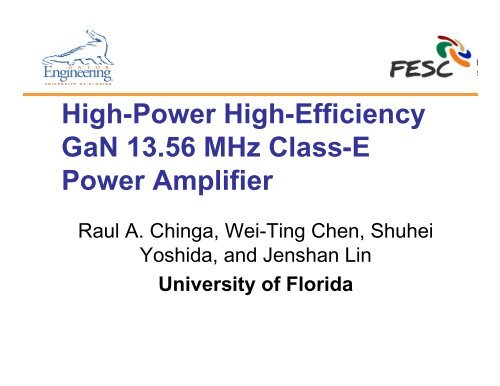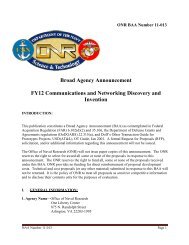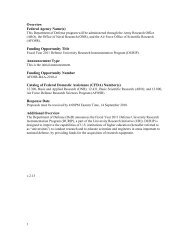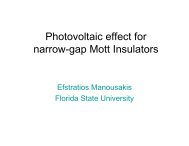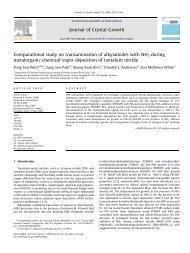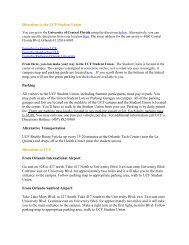High-Power High-Efficiency GaN 13.56 MHz Class-E Power Amplifier
High-Power High-Efficiency GaN 13.56 MHz Class-E Power Amplifier
High-Power High-Efficiency GaN 13.56 MHz Class-E Power Amplifier
You also want an ePaper? Increase the reach of your titles
YUMPU automatically turns print PDFs into web optimized ePapers that Google loves.
<strong>High</strong>-<strong>Power</strong> <strong>High</strong>-<strong>Efficiency</strong><br />
<strong>GaN</strong> <strong>13.56</strong> <strong>MHz</strong> <strong>Class</strong>-E<br />
<strong>Power</strong> <strong>Amplifier</strong><br />
Raul A. Chinga, Wei-Ting Chen, Shuhei<br />
Yoshida, and Jenshan Lin<br />
University of Florida
Team<br />
• Dr. Jenshan Lin, Professor in Electrical<br />
and Computer Engineering<br />
• Raul A. Chinga, Graduate Student<br />
• Wei-Ting Chen, visiting researcher from<br />
the Industrial Technology Research<br />
Institute, Taiwan.<br />
• Shuhei Yoshida, visiting researcher from<br />
NEC, Japan.<br />
2
Motivation<br />
We are<br />
transitioning to a<br />
future where<br />
everything and<br />
everybody will be<br />
connected to<br />
each other<br />
wirelessly…<br />
3
Motivation<br />
4
Motivation<br />
Cutting the last cord…<br />
Wireless power…<br />
5
Motivation<br />
Global Unit Shipments of Wireless Local Area Network<br />
(WLAN) Capability in Suitable Electronic Products<br />
The wireless device market is rapidly<br />
growing<br />
WLAN devices will reach over 2 billion by<br />
2015<br />
Wireless Charging Devices will reach<br />
almost 250 million by 2014<br />
‣Near Field Communication (NFC) devices will<br />
reach over 1/2 billion by 2015<br />
‣Mobile phone connections will reach 6 billion<br />
by 2012<br />
6
Proposed work: Efficient<br />
<strong>Power</strong> <strong>Amplifier</strong><br />
System block for wireless<br />
communication and power<br />
transmission<br />
<strong>Power</strong> <strong>Amplifier</strong>s are an<br />
important aspect of any<br />
wireless system Total system efficiency=(n T )x(n c )x(n R )<br />
7
<strong>Class</strong> E <strong>Amplifier</strong><br />
Goal: To design a high efficient power amplifier capable of delivering<br />
high power for wireless communications and/or wireless power<br />
transmission applications.<br />
•100% theoretical efficiency<br />
•Low number of components<br />
•<strong>High</strong> reliability<br />
‣Voltage and Current across transistor<br />
do not overlap, hence no power loss<br />
8
Challenges<br />
• Operating at <strong>13.56</strong> <strong>MHz</strong> brought up a few<br />
complications:<br />
1. Internal shunt capacitance across the drain and source of<br />
transistor is not negligible<br />
2. Rising and falling time has to be small enough to achieve<br />
proper switching at <strong>13.56</strong><strong>MHz</strong><br />
3. <strong>High</strong> Q for the load requires a large inductor (L2). The<br />
larger the inductor the larger the parasitic resistance,<br />
causing greater power loss across the inductor<br />
9
Transistor selection<br />
• <strong>Power</strong> MOSFETs<br />
– Advantages:<br />
• Capable of handling large currents and voltages.<br />
• Robust<br />
• Cheap<br />
– Disadvantages<br />
• Not meant to be used at <strong>13.56</strong><strong>MHz</strong>.<br />
– Large Cds<br />
– Slow switching time<br />
• RF transistors<br />
– Meant to be used at really high frequency providing very<br />
low power<br />
– Very expensive 10
Gallium Nitride(<strong>GaN</strong>)<br />
Transistor<br />
• Small capacitance across drain and source<br />
• Fast rising and falling times, allowing proper switching at<br />
<strong>13.56</strong> <strong>MHz</strong><br />
• <strong>High</strong> Vds and ID, thus allowing high power delivery<br />
• Very small package<br />
‣ Disadvantage: Very delicate. It can only dissipate 1W and<br />
gate voltage cannot exceed 6V, otherwise transistor could be<br />
destroyed<br />
11
Circuit Implementation<br />
Removed. Internal<br />
shunt capacitor is<br />
sufficiently large<br />
M1 EPC1010 C1 690pF<br />
Gate<br />
Driver IXDI502 C2 0.1uF<br />
Oscillator K50-HC C3 0.1uF<br />
L1 50uH C4 0.1uF<br />
L2 0.3uH C5 22uF<br />
Rload 13ohm C6 0.1uF<br />
C7 22uF 12
Results<br />
13
Conclusions<br />
Other work:<br />
‣1W <strong>Class</strong> E at 82% efficiency<br />
‣13.4 W <strong>Class</strong> E at 93% efficiency<br />
This work:<br />
‣Achieved output power of 27W at 92% efficiency<br />
‣Successful <strong>Class</strong> E power amplifier at <strong>13.56</strong> <strong>MHz</strong><br />
‣<strong>GaN</strong> has been proven to work very well at this<br />
frequency and deliver high power.<br />
14


